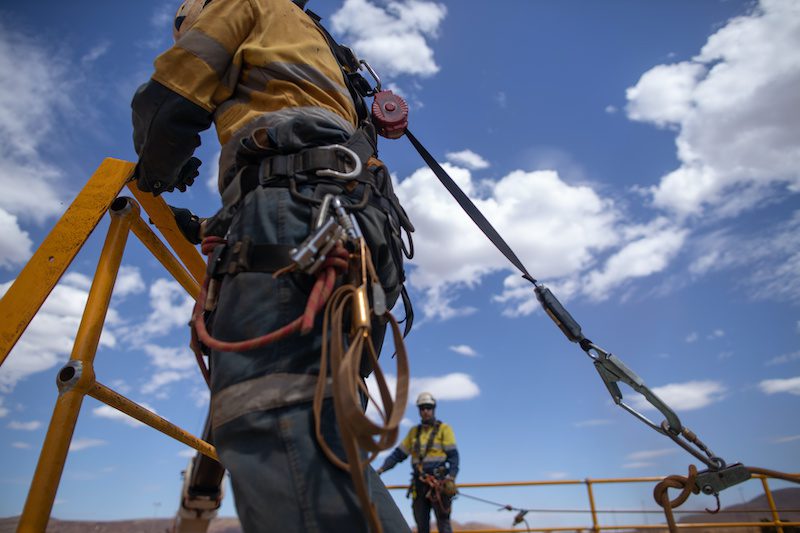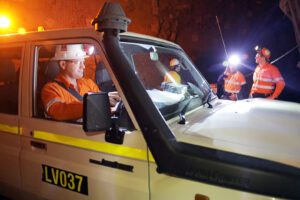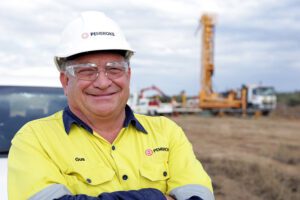Working at height remains one of the greatest causes of fatalities and major injuries on Australian worksites, with many workers finding themselves in positions where they are expected to work at height with little or no knowledge of the risks involved. A height safety authority sets out these risks with a focus on the construction industry, explaining the importance of risk assessments and fall protection systems, and offering some key dos and don’ts.
The Australian workforce has many trades that require workers to utilise their skills in the occupation of their choosing, all of whom have been trained in the skills needed to carry out the work required. These workers often find themselves in positions where they are expected to work at height either above or below ground, often with little or no knowledge of the risks they face as there is no legislated requirement other than a recommendation for training in work practice documents for these people to have had at least minimal training in the recognition of risk and the means to minimise those risks and dangers they face when working at height.
Falls from height remain a high risk in Australian workplaces
Fall of ground incident in a development heading resulting in serious injury
Working at height remains one of the largest causes of fatalities and major injuries, and the need to train those who work at height should be paramount among managers, persons conducting a business or undertaking (PCBUs) and others working in these areas of risk. When working at height there are a number of risks and fatality and injury causes that include falls from ladders, through fragile surfaces over edges, and off structures and other assets; in fact, ‘work at height’ means work in any place where, if there were no precautions in place, a person could fall over, fall through or even trip and possibly fall a distance that may cause personal injury or death.
Construction
In their document ‘Construction industry profile’, Safe Work Australia has shown that the number of workers in the industry has grown by 33% over the last 11 years and draws together various occupations, which include but are not limited to:
- Scaffolders
- Painters
- Bricklayers
- Roofers
- Plumbers
- Engineers
- Builders
- Maintenance workers
New South Wales
In a similar document, SafeWork NSW indicated that in 2010–11, a fall from height accounted for 7730 claims for serious injury. This means that 21 employees each day lodged a claim for a falls-related injury that required one or more weeks off work, and males accounted for three-quarters of the falls-related claims. Within the construction industry, 76% of workers were classed as employees and were covered by workers compensation schemes, and there have been significant reductions in the numbers and rates of injuries and fatalities in this industry over the last 10 years or more. Yet in 2013–14, the construction industry again accounted for 9% of the workforce, but 12% of work-related fatalities. Around 12,600 workers compensation claims are accepted from the construction industry each year for injuries and diseases involving one or more weeks off work. This equates to 35 serious claims each day. In 2012–13, the construction industry had the fourth-highest incidence rate of serious claims per 1000 employees, and had the fifth-highest fatality rate per 100,000 workers in 2013–14.
In NSW, falls from height account for some 35% of injuries and death in construction and mining, though it is interesting to note that this industry is not the most deadly — the transport, postal and warehousing industry heads the list with 38% of the deaths, with SafeWork NSW listing falls from trucks/vehicles as a high risk. Although the regulator has advised that there have been significant reductions in the numbers and rates of injuries and fatalities in the construction industry over the last 10 years or more, height work and falls are still a major cause of death and serious injury (in construction and beyond). This is due to the type of work carried out across a range of industries, including: stacking shelves, working on a roof, unloading a large truck or accessing silos. Falls can also occur at ground level into holes, for example, trenches or service pits.
Fallout
Working at height is high risk and remains one of the biggest causes of fatalities, and we should not lose sight of the seriousness of injuries that can occur and which are ongoing and often life-changing. There is an awesome amount of information available on the internet related to working at height, including its risks, injuries, the death rate and responsibilities of the PCBU. We can often find the $ penalties when workers or employers and companies are fined; what we cannot find in the documents are the feelings of devastation and mental cost that workers and companies who have been involved in a fall incur. There are many articles available through the regulators in each of the states and territories on the investigation and resulting outcomes of a fall from height. I have chosen one from WorkSafe Victoria. As a news article, it is less complex than others, which helps to show the outcome of an accident and the analysis of the accident by the magistrates’ court.
Case study: WorkSafe Victoria 2018 news article
In the article, titled ‘Construction company fined following fall fatality’ (and accessible at www.worksafe.vic.gov.au/news/2018-12/construction-company-fined-following-fall-fatality), it is reported that a Melbourne construction company had been convicted and fined $275,000 following the death of a painter who fell 3.46 metres through a stair void at a Mornington Peninsula building site.
The company pleaded guilty in the Melbourne Magistrates’ Court to contravening section 26 of the OHS Act when it failed to ensure that the workplace was safe and without risks to health. The company was ordered to pay $7500 in costs. The news item notes: “A WorkSafe investigation found a wooden handrail at the edge of the first-floor void near where the painter was working had been partially dislodged from one of its clamps.”
When we look at the fall incident in this case we can see that falls are not always about fall arrest equipment that are designed to keep workers safe. Rather, it is really about understanding the risk itself, which can often be easily seen if we take the time to carry out a risk assessment of the work and the workplace.
Work at height risk assessment
A risk assessment is a careful examination and recognition of what in your workplace could cause harm to those who are to carry out work. It enables you to weigh up whether you have taken enough precautions, or should do more to prevent harm. Employers and employees are required to assess the risks in their workplace so that they can put in place a plan to control those risks. It’s crucial for you to know how to carry out a risk assessment to ensure people can work safely. When creating a work at height risk assessment there are at least 5 key steps:
- Identifying the hazards.
- Deciding who might be harmed and how.
- Evaluating the risks and deciding on precautions.
- Recording your findings and implementing them.
- Reviewing your assessment and updating if necessary.
There is a range of resources available online. The Queensland Government’s Department of Education has a working at heights risk assessment template that can be used, for example (accessible at www.education.qld.gov.au/initiativesstrategies/Documents/working-heights-risk-assessment-template.DOCX). Such resources are designed to assist workplaces in managing fall hazards in the workplace. This includes situations that those working in construction are routinely exposed to, such as:
- off the ground (eg, up ladders, on work platforms, or on roofs);
- on the ground close to deep holes (eg, excavations) edges or ledges (eg, retaining walls);
- openings through which people could fall (eg, skylight); or
- in areas where objects may fall from higher levels and cause injury.
While having a template to work with is helpful, it is also highly recommended that persons carrying out a risk assessment have training to enable them to understand and recognise the risks that they or workers they are responsible for are faced with, which will better enable relevant persons to put in place appropriate safeguards.
Dos and don’ts
Working at height is considered a high-risk occupation, which normally means that an individual is working in a place that requires necessary precautions to prevent them from falling a distance, resulting in serious injury or death. We know that injuries resultant from working at height remain among the most prominent causes of serious injuries and fatalities. In particular, falls from ladders, scaffolding, and vehicles and structures of any type can cause serious injury, even when the height is perceived to not be dangerous.
Employers and employees need to ensure that they take all measures necessary to lower the risk of falling from a height, and should do so by using pre-emptive hazard recognition and constant site assessment. To restrict the potential for a fall — including but not limited to when preparing work that may require the worker to work at height — there are a number of suggested dos and don’ts. (The dos and don’ts list is a general guide. While useful as a guide on what to look for, it cannot replace the need for training to provide the competence that workers and employers require.)
Dos
DO as much work as you can while you are on the ground.
DO make sure that you and others can safely move to and from the area where working at height takes place.
DO ensure that the equipment that you’re using for the job is strong, stable and suitable enough to get the job done. Inspect and maintain this equipment regularly.
DO be careful when you are working near a fragile surface.
DO ensure that you are protected from falling objects.
DO make preparations for emergency evacuations and rescues.
DO make sure that personal protective equipment (PPE) is in good order and fit for use.
DO make sure that you and other at-height workers understand the risk.
DO ensure that you and other at-height workers are properly trained.
Don’ts
DON’T overload the ladders that you are working on, with equipment or materials.
DON’T try to reach too far when you’re on a ladder or stepladder.
DON’T use ladders or stepladders to do work that entails heavy or strenuous tasks. Only use them to do work that’s quick and light.
DON’T allow incompetent workers to do any work at height.
DON’T lean or place the ladder on fragile upper surfaces.
DON’T stay quiet when you feel someone is compromising their own safety or the safety of others.
DON’T use PPE when you cannot confirm its suitability for use.
Fall protection systems
It is said that a tool is most effective when the user knows how to operate it properly, so it can achieve its intended purpose. This point is especially true when that tool is an element of a fall protection system (which may be used in conjunction with the risk assessment of the work to be carried out), since misuse of that equipment can lead to a serious injury or fatality, and costly damage to the equipment itself. Fall protection has historically been a great concern requiring the state and territory regulators to provide a plethora of information, such as: work practice documents, compliance notices, and warning and advice notes. Yet falls continue to be a leading cause of fatalities in Australian industrial workplaces.
Employers can, however, take steps to reduce fall injuries and fatalities by understanding how to properly design, implement and use fall protection systems through quality training of workers and managers. The key to addressing the risks of working at height is to ensure that users have the training and supervision to identify the risks, and that correct equipment and processes are used and understood so that workers can do their jobs safely. Organisations should strive to avoid putting workers in situations where they need fall protection systems; however, when those cases do arise, they should see that the systems in place are designed, implemented and used correctly. You can find further guidance on the proper use of fall protection equipment and developing a fall protection program in Australian Standard AS/NZS1891.4 Care and Use of Industrial Fall Arrest Systems.
Read more Mining Safety News














Add Comment